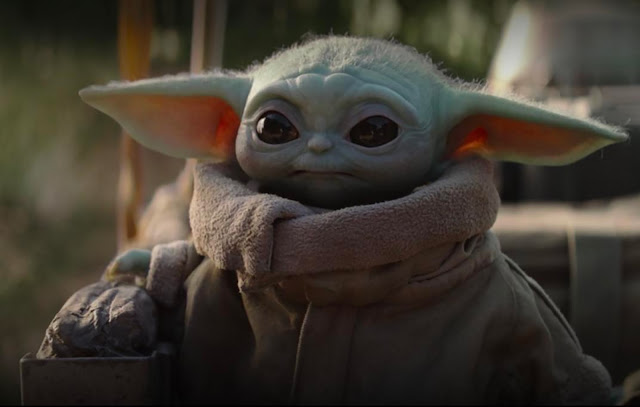The only Star Wars I really rate is the original 1977 film. I expect that’s mostly because I was twelve when it came out, but I do think it’s far superior to all the sequels and prequels which followed. Movie buffs would claim The Empire Strikes Back is better, but for me that's where it all starts to go wrong, when Luke goes off to spend a large chunk of the film being trained in the ways of mystical codswallop by a muppet. The Force and the Jedi Knights are an important detail in the original Star Wars, and provide a powerful, mythic flavour that instantly separates it from the shiny, gadgety sci-fi we were used to in the ‘70s, but they’re a fairly small part of the story. The closer they get to centre stage in the later films, the more boring they become. It’s no coincidence that the nearest the Star Wars franchise has got to producing good films since 1983 is with Rogue One and Solo, in which the Force barely features.
And now The Mandalorian. Disney are drip-feeding us their new TV show an episode per week here in the UK, presumably in a cunning plan to stop us all bingeing through it on our free trial period and cancelling our accounts, so I’m judging it solely on the strength of its first four episodes.
The Mandalorian of the title is a nameless bounty hunter, who roves around outback planets in the power vacuum left by the fall of the Galactic Empire, tracking down fugitives and using the reward money to buy himself fancier bits of armour. In episode one he takes a commission from a sinister ex-Imperial official, played by top Teutonic funmeister Werner Herzog (my favourite bit of left-field casting in a sci-fi show since Iggy Pop popped up as an alien in Deep Space Nine). The target turns out to be a tiny green alien baby - now known to the world as ‘Baby Yoda’ though I presume it can’t actually be baby Yoda, just a baby one of whatever-species-Yoda-is. Our masked hero decides to protect it rather than turn it in.
And that’s it, basically. The simplicity of the plot and set-up harks back to the original Star Wars, and so do the settings - dusty frontier worlds which have that sense of existing somehow in both the past and the future, one of the things which first grabbed my imagination back in ’77. The production design runs lovely variations on familiar shapes and textures from the Star Wars universe. The hero never takes his helmet off, but we learn to read his emotions by just looking at the T-shaped glass eyepiece of his visor. (Another thing that felt new and strange about Star Wars when it came out was just how many of the faces on the screen were actually masks or helmets.) Sometimes, as the cold light of an alien desert reflects from his armour, the Mandalorian looks as if he’s stepped out of Excalibur; mostly the visual references are to westerns and samurai movies (key building blocks of the original Star Wars).
The episodes are quite short, and pretty much self-contained so far, which is refreshing. It has the feel of shows I remember from my childhood, like Logan’s Run or Alias Smith and Jones, where the fugitive heroes travelled to a new location and a new adventure each week. There is lots of spaghetti-western-ish violence, but it’s strictly of the pew-pew-you’re-dead variety - there’s no gore, and no on-screen suffering. It feels aimed at kids, which is refreshing after watching Star Trek embarrass itself by trying to act all sweary and grown-up. It all looks very expensive. One of those unlikely Imperial walkers is shot in a way which actually makes it seem menacing and dinosaurish (still fairly easy to trip up though). The Mandalorian’s spaceship looks like the offspring of a B52 and an Airstream trailer. There’s a very funny gunslinger droid in the first episode, who needs to be brought back. Werner Herzog is his usual cheery self. The Baby Yoda puppet is genuinely adorable. The Force is present as a MacGuffin, but so far hasn’t even been mentioned by name. So all in all, it’s probably the most enjoyment I’ve had out of a new Star Wars thing since I was twelve. Yay!

Comments